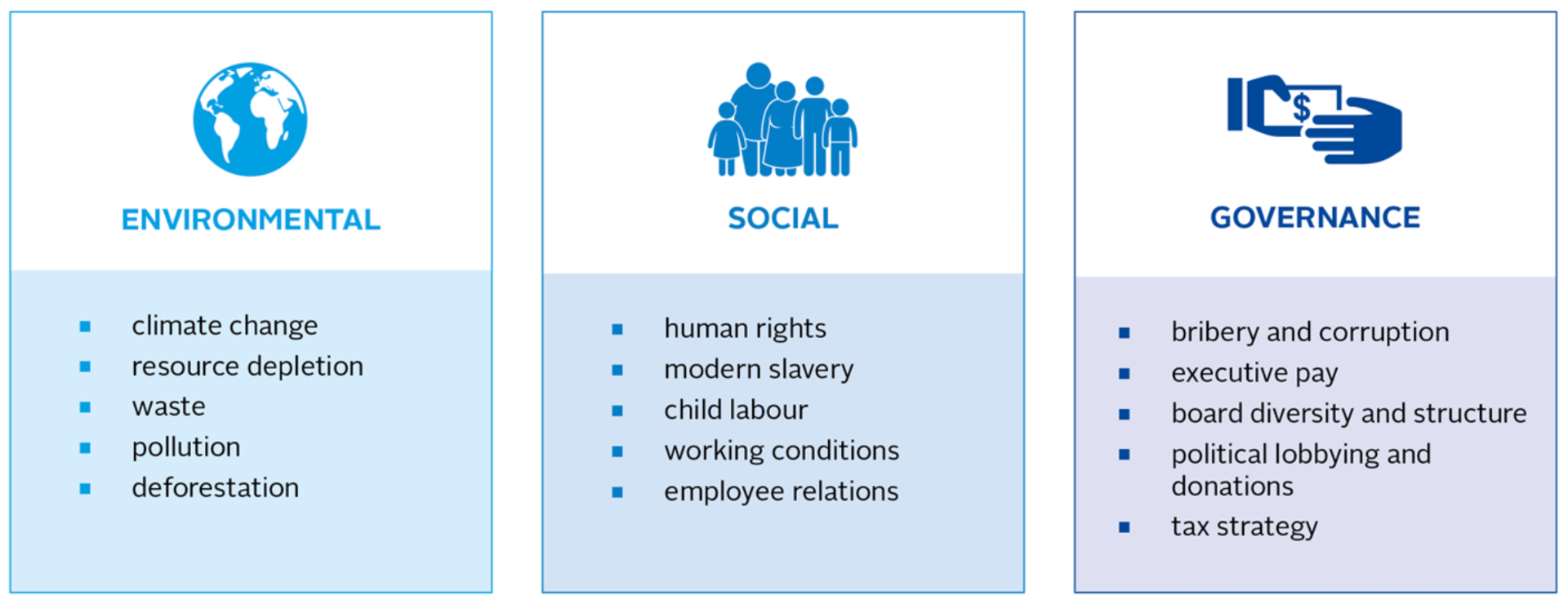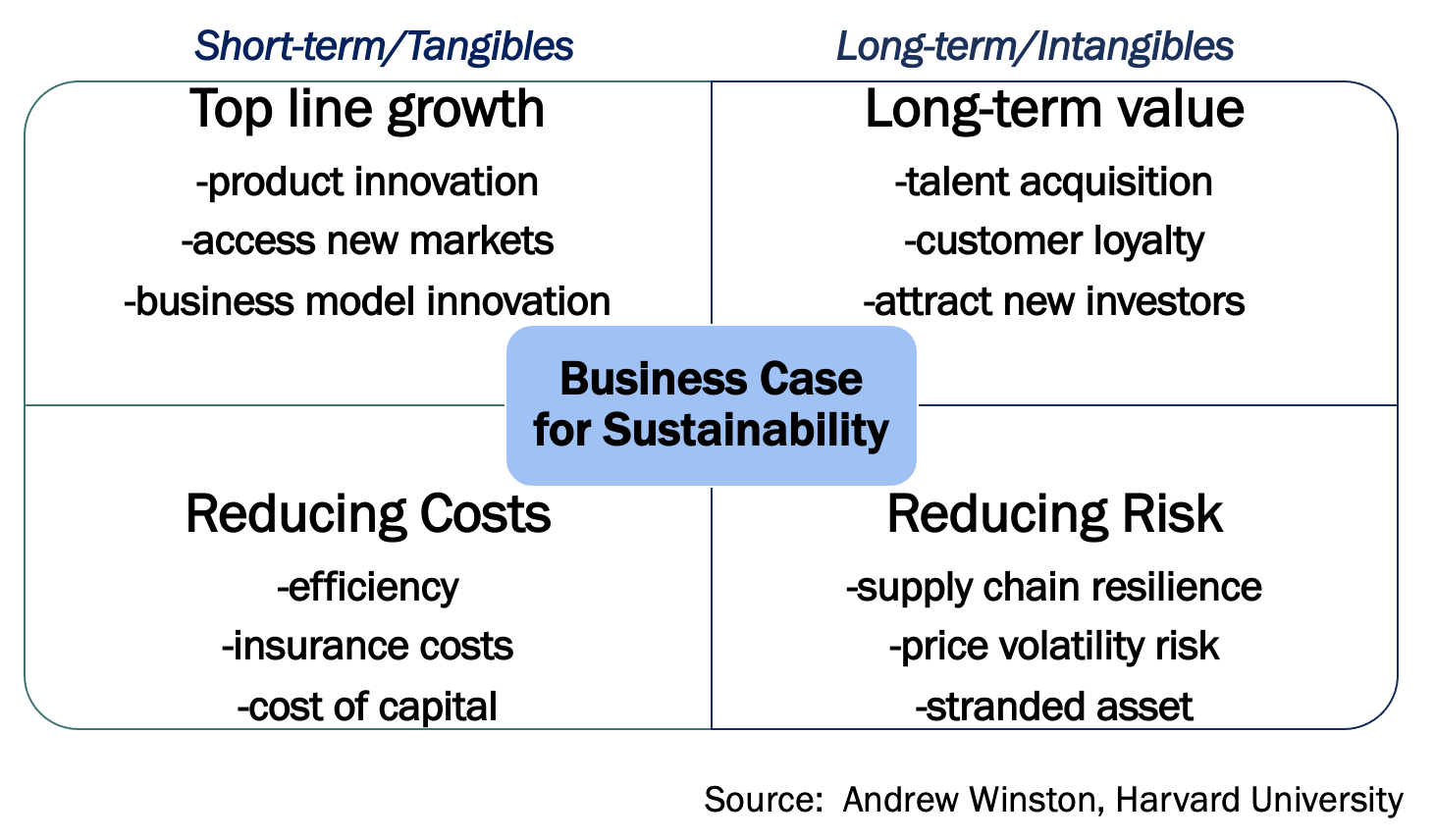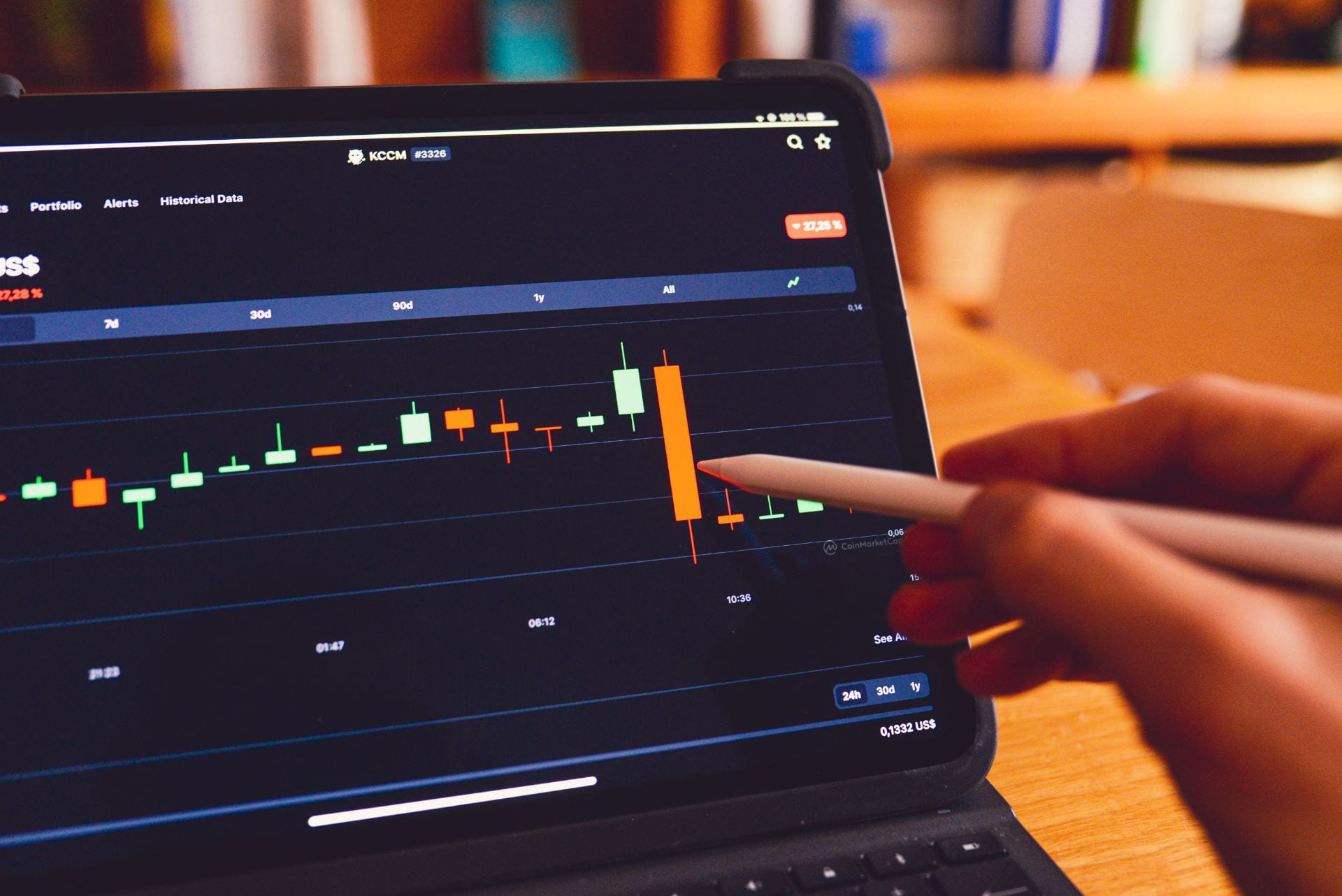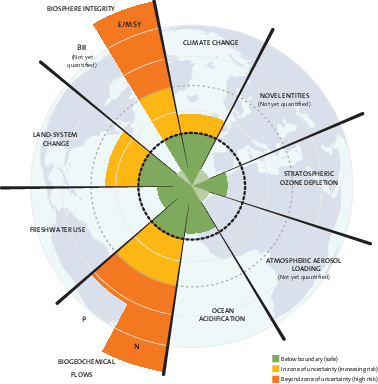Sustainable Business
Origins and Definitions: The Basic Concepts of Sustainability/ESG in Business
Some incorrectly believe sustainability and the triple bottom line are only about the environment. However, both of these concepts are also about equity, human rights, and economic prosperity. From the original text of Our Common Future, we read that:
“Poverty is a major cause and effect of global environmental problems. It is therefore futile to attempt to deal with environmental problems without a broader perspective that encompasses the factors underlying world poverty and international inequality.”
In 2005, Environmental, Social, and Governance (ESG) was coined by United Nations Environment Programme (UNEP) Finance Initiative in the Freshfields Report and the Who Cares Wins report from UN Global Compact.
Today we can look to the Sustainable Development Goals (SDGs) for further evidence that sustainability is as much about people and prosperity as it is environmental protection. In fact, all are needed for life to be sustained. Sustainability tells us that all business decisions should be socially equitable, environmentally responsible, and financially viable.


The Business Case for Sustainability/ESG
A common, but quickly changing, misconception among some executives is that sustainability costs too much and that social and environmental issues are the responsibility of governments and the non-profit sector.
Considering how issues from climate change to human rights violations impact business, this misconception is an increasingly risky management strategy. Instead, research shows that sustainability not only is better for society but also has a positive financial impact when it is incorporated into a company’s core business strategy.
The graphic on the left shows four ways that sustainability can be financially smart for an enterprise, in the short and long term.
According to HBR’s “The Comprehensive Business Case for Sustainability,“ sustainability benefits a wide variety of corporate functions, including competitive advantage, risk management, innovation, financial performance, customer loyalty, and employee engagement.
To see companies at the forefront of realizing the business case for sustainability, check out Barron’s List of the Top 100 Sustainability Companies or the Wall Street Journal’s Top 100 Sustainability Leaders.

Four Ways to Make the Business Case for Sustainability
(Image adapted from: Andrew Winston, Harvard Business School)
Defining the Three Pillars of Sustainability

People - Social Bottom Line
Companies that follow the triple bottom line framework in business think about and take responsibility for the impact their operations and products have on people, intended or not. A company focused on the social bottom line internally features sound health care, maternity and paternity leave, fair working hours, and advances diversity and inclusion. Externally, such an enterprise focuses on labor force rights in their supply chain, supplier diversity, and even the impact of investments. The “people” bottom line also focuses on the communities where the company does business. This includes reversing the inequalities that exist in access to education, healthcare, and clean drinking water.

Planet - Environment Bottom Line
Triple bottom line companies take pains to identify, reduce, or eliminate their ecological footprint. They strive for environmental benefit, recognizing the fact that doing so is the right thing to do and is good business. But it’s not just about the money. Triple bottom line companies look at the entire life cycle of their operations and products to determine the true environmental cost. They measure this cost by looking at global impacts on issues like climate change, ocean acidification, biodiversity, and pandemics, and locally on resources like water, soil, localized air pollution, and the degradation of natural areas.

Profit - Economic Bottom Line
Companies must be profitable and competitive or they won’t be around to bring positive change to society. When looking at profit from a triple bottom line standpoint, the idea is that profits will help empower and sustain the community as a whole, and not just flow to the CEO and shareholders. In addition, the financial bottom line is oftentimes met by reaching the other bottom lines. For example, decreasing water usage in manufacturing has a positive impact on the environment, but it also could cut back on costs for the company. Appropriate executive compensation and a company’s lobbying and investing activities are also part of the total economic bottom line for a forward-looking company.
Case Examples: Sustainable Business/ESG Takes Many Forms
Large Corporation
Audrey Choi, Chief Sustainability Officer at Morgan Stanley
Disruptive Social Innovation
FairPhone – the world’s most sustainable mobile phone
Social Entreprenuer
Tru Colors Brewery – run by rival gangs with a mission to end gun violence
What Drives Sustainability/ESG?
While the list of sustainability drivers is long, the main drivers that fuel most others are population growth, intensive resource usage rate, climate change, and inequality/social injustice. In fact, the World Economic Forum (WEF) publishes an annual WEF Global Risks Report that routinely identifies emerging social and ecological trends driving change in business.
Population Growth and Increased Consumption: The population is expected to reach 9 billion people by 2043. What is the population right now (Worldometer)? The concern isn’t just population but consumption. According to NASDAQ the global middle class, defined as adults with between $10,000 to $100,000 in assets, increased from 507 million in 2000 to 1.7 billion in 2020. Some forecast we will reach 5 billion by 2050. This is a very good thing as it equates to people leaving poverty, especially extreme poverty. However, it also equates to higher levels of resource consumption.
According to the World Resources Institute (WRI), the planet will have 3 billion more people to feed than there were in 2010. Just consider the water, soil and land needs that will be required and the critical equity considerations about who gets to eat–and who does not.


Climate Change: The basic science of climate change has been known since the 1800s and since the 1970s there has been substantial global scientific, business and general public awareness of a changing climate due to human-produced greenhouse gas (GHG) emissions. Over half of all emissions have been emitted to the atmosphere in just the last 30 years.
Today the concentration of carbon in the atmosphere is higher than it has been in 800,000 years, perhaps as long as 15 million years. We are all now painfully aware of the increase in natural disasters from forest fires to floods to droughts with the greatest impacts on the world’s most vulnerable. (Wallace-Wells, 2019)
Pressure on Natural Resources and Planetary Boundaries: Not only is the global population growing, but consumption levels are also increasing. (see note on growing middle class above).
This dual trend of increasing population and consumption has created an increase in the use of natural resources, pressures on natural systems (like the climate and oceans) to absorb our pollutants, and has humanity surpassing the natural thresholds–the planetary boundaries–of the earth.
The Global Footprint Network estimates which countries are exceeding their “ecological budget”. And what about the climate budget? The Global Carbon Project’s Annual Carbon Budget scientifically tracks how much carbon is emitted, removed, and added to the atmosphere and oceans every year. In business terms, we are “in the red” every year.

Inequality and Social Injustice: Our world faces inequalities in access to education, healthcare, jobs, and even basic sanitation and clean water. These issues have been caused by and advanced by the historic systems of prejudice woven into major societal institutions.
The potential to reach more people, especially communities that have previously been dismissed, faced disinvestment or just disregard, makes social injustice a major driver of sustainability.
Sustainable Development Goals
One of the most widely adopted responses to these social, economic and environmental drivers are the UN Sustainable Development Goals (SDGs): 17 goals to address global social, economic, and environmental challenges.
The goals are interconnected and intended to be met by 2030. Most businesses and business people serious about sustainability/ESG are familiar with and refer often to the SDGs. Moreover, tools like the SDG Compass have been created specifically to help businesses incorporate the SDGs into their strategy, culture, and operations.
And Finally…Sustainable Business/ESG is Not Without It’s Critics
Sustainable business, social responsibility, ESG, and social entrepreneurship are exciting concepts about “doing well while doing good” but are not without their critics. The most thoughtful contrarians are worth listening to as their warnings can keep sustainability from running afoul of its higher purposes (and legal requirements). The skillful and informed student and professional needs to understand these basic critiques.
Here we will provide a brief overview of the two main lines of criticism:
Critique #1: Sustainability is about sustaining the business– attracting employees and customers, accessing new markets, lowering costs and avoiding regulations–and not about making any measurable changes to how it impacts people and the planet.
“What we call ‘eco-business’–taking over the idea of sustainability and turning it into a tool of business control and growth that projects an image of corporate social responsibility–is proving to be a powerful strategy for corporations in a rapidly globalizing economy marked by financial turmoil and a need for continual strategic repositioning…True or ‘deep’ sustainability requires restoring and protecting ecosystems and communities, and not, as every big brand is doing, first and foremost trying to use sustainability to enhance the efficiency of production and the quality of products to speed along growth.” (Peter Dauvergne and Jane Lister, Eco-Business: A Big Brand Takeover of Sustainability, 2013)
Critique #2: Sustainability is a distraction and drain on the profit-making function and legal responsibility of the enterprise
“The business [people] believe that they are defending free enterprise when they declaim that business is not concerned ‘merely’ with profit but also with promoting desirable ‘social’ ends; that business has a ‘social conscience’ and takes seriously its responsibilities for providing employment, eliminating discrimination, avoiding pollution and whatever else may be the catchwords of the contemporary crop of reformers.”
“In fact they are—or would be if they or any one else took them seriously— preaching pure and unadulterated socialism. Businessmen who talk this way are unwitting puppets of the intellectual forces that have been undermining the basis of a free society these past decades.” (Milton Freedman, “The Social Responsibility of Business is to Increase its Profits”, NY Times, 1970)



